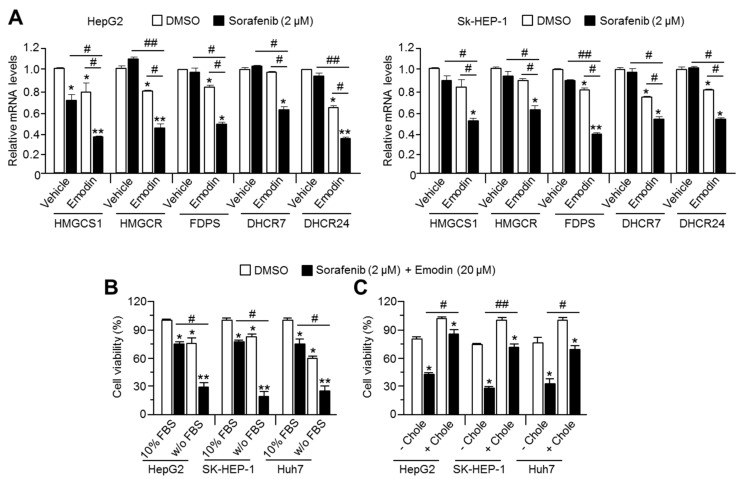Figure 5.
Suppression of cholesterol metabolism is required to sensitize HCC cells to the anti-cancer effect of sorafenib. (A) Cholesterogenic gene expression after the combination treatment of emodin and sorafenib in HepG2 and SK-HEP-1 cell lines. The cells were incubated with emodin (20 μM), sorafenib (2 μM), or their combination (20 μM emodin and 2 μM sorafenib) for 24 h. The values represent the mean ± SEM of three independent experiments performed in duplicate; * p < 0.05, ** p < 0.01, # p < 0.05, and ## p < 0.01. (B) The cell viability after the combination treatment of emodin and sorafenib in the absence or presence of 10% fetal bovine serum (FBS). Three cell lines were incubated with 10% FBS or FBS-free serum for 1 h prior to the combination treatment of emodin and sorafenib. Subsequently, the cells were incubated for 24 h with the indicated treatments. The values are presented as the mean ± SEM of three independent experiments performed in triplicate; * p < 0.05, ** p < 0.01, and # p < 0.05. (C) The cell viability after the combination treatment of emodin and sorafenib in the absence or presence of water-soluble cholesterol (0.5 mM). Three cell lines were incubated with or without 0.5 mM water-soluble cholesterol for 1 h prior to the combination treatment with emodin and sorafenib. Subsequently, the cells were incubated for a further 48 h. The values represent the mean ± SEM of three independent experiments performed in triplicate; * p < 0.05, ** p < 0.01, # p < 0.05, and ## p < 0.01.

